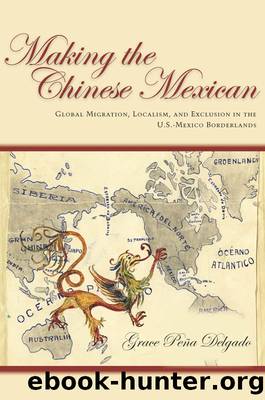Making the Chinese Mexican by Grace Delgado

Author:Grace Delgado [Delgado, Grace]
Language: eng
Format: epub
Tags: History, Latin America, Mexico, Asia, China
ISBN: 9780804783712
Google: IuTtxo2Za_UC
Publisher: Stanford University Press
Published: 2013-04-15T01:09:27+00:00
6 Por la Patria y por la Raza (For the Fatherland and for the Race)
SINOPHOBIA AND THE RISE OF POSTREVOLUTIONARY MEXICAN NATIONALISM
Hip Lee and Lung Yink Han were not alone in objecting to the creation of barrios chinos (Chinese neighborhoods), but they served as powerful examples of Chinese resistance. The decree, known as Law 27, gave Sonoran municipal officials the authority to relocate Chinese, their families, and their businesses into designated areas throughout the state beginning in late December 1923.1 No doubt Law 27 conveyed the hatred of many Sonorans for their Chinese neighbors. To counter the segregation decree, members of the Chinese community flooded local courts with petitions objecting to Law 27. Amid the barrage, Lee and Hanâs appeal stood out. Their words, sharp and shrewd, drew out the capriciousness of the barrioization decree. They presented themselves not as isolated individuals but as Mexicans who were entitled to the civil rights guaranteed to all. These two Nogales residents, by invoking Mexican constitutional tradition, outlined the breadth of national belonging, as embedded not only in political rights but also in the âfull enjoyment of social and private rights.â After leveling further charges and accusing state authorities of devising a law so cruel it defied common notions of human decency, Lee and Han affirmed simply and directly that no political body could constrain individual liberties, no matter what the rationale.2
Without question, Lee and Han and the other petitioners were standing on firm ground. In an unrelenting effort to crush Sonoran Chinese, local lawmakers violated constitutional guarantees when the barrioization decree was created. With the assistance of a Nogales-based attorney, Arsenio Espinoza, who drafted appeals on behalf of Chinese clients, Lee and Han also made it clear that the motivation behind Law 27 was bigotry against the Chinese and their families. Lee and Hanâs appeals struck a nerve, and in 1925, shortly after Chinese petitioners drew out their legal arguments against barrioization, Sonorans ended all courtroom pursuits of mandatory relocation. But when lawmakers passed the barrioization decree in late 1923, most lawmakers believed it was within their legal bounds to do so. A sizable cadre of local officials hinged the legality of Law 27 on Article 40 of the Mexican Constitution, which recognized that âstates are free and sovereign in all internal matters, and on that basis, can legislate on any subject.â3 Such understanding of legislative jurisdiction was in keeping with a long-standing governing tradition in Sonora that favored localism over federal powers. The barrioization decree represented this governance preference, as did other anti-Chinese labor, sanitation, and marriage legislation. Although these prohibitive laws went unenforced for a while, the tension between local and federal control did bring into sharp relief the manner in which antichinistas pursued discourses of racial exclusion and, conversely, how Sonoran Chinese reasserted claims of civic inclusion over the course of the next decade.
It was clear from the nature of anti-Chinese legislation that the struggle over civic belonging in postrevolutionary Sonora would be fought on both public and private grounds.
Download
This site does not store any files on its server. We only index and link to content provided by other sites. Please contact the content providers to delete copyright contents if any and email us, we'll remove relevant links or contents immediately.
Cat's cradle by Kurt Vonnegut(15265)
Pimp by Iceberg Slim(14441)
4 3 2 1: A Novel by Paul Auster(12334)
Underground: A Human History of the Worlds Beneath Our Feet by Will Hunt(12055)
The Radium Girls by Kate Moore(11978)
Wiseguy by Nicholas Pileggi(5716)
The Fire Next Time by James Baldwin(5390)
Perfect Rhythm by Jae(5361)
American History Stories, Volume III (Yesterday's Classics) by Pratt Mara L(5276)
Paper Towns by Green John(5142)
Pale Blue Dot by Carl Sagan(4961)
A Higher Loyalty: Truth, Lies, and Leadership by James Comey(4909)
The Mayflower and the Pilgrims' New World by Nathaniel Philbrick(4463)
The Doomsday Machine by Daniel Ellsberg(4453)
Killers of the Flower Moon: The Osage Murders and the Birth of the FBI by David Grann(4411)
The Sympathizer by Viet Thanh Nguyen(4346)
Too Much and Not the Mood by Durga Chew-Bose(4305)
The Borden Murders by Sarah Miller(4279)
Sticky Fingers by Joe Hagan(4148)
